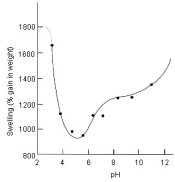I tried to find some information about how much pig skin food grade gelatin swells at different pH values, as I remember PE saying that photo grade cow bone gelatin has a maximum swell a pH=9 and pig gelatin at pH=3 or something like that.
All I found was http://jgp.rupress.org/cgi/reprint/12/4/537.pdf , at page 4, but it doesn't show pH after 4. So, I made an evaluation myself.
I made six buffered 300 ml pH solutions (using H2SO4, citric acid, fluoric acid and NaOH) ranging from 4.0 to 10.4, cut 1.00 gram of gelatin sheet to each of them, let to swell at 23C room temp for 1 hour 45 mins. Then I drained each sheet for 20 seconds and measured the weight.
Here's the results:
Pig skin gelatin swell at 23C, 1 hour 45 mins
Swelling in gram of H2O per gram of gelatin:
pH = 4.0: 5.41 grams
pH = 5.2: 5.28 grams
pH = 6.4: 5.24 grams
pH = 7.7: 5.13 grams
pH = 9.2: 5.16 grams
pH = 10.4: 5.20 grams.
So, there seems to be no real difference at pH range of 4...10 when washing the emulsion noodles, if you use food grade (pig) gelatin.
All I found was http://jgp.rupress.org/cgi/reprint/12/4/537.pdf , at page 4, but it doesn't show pH after 4. So, I made an evaluation myself.
I made six buffered 300 ml pH solutions (using H2SO4, citric acid, fluoric acid and NaOH) ranging from 4.0 to 10.4, cut 1.00 gram of gelatin sheet to each of them, let to swell at 23C room temp for 1 hour 45 mins. Then I drained each sheet for 20 seconds and measured the weight.
Here's the results:
Pig skin gelatin swell at 23C, 1 hour 45 mins
Swelling in gram of H2O per gram of gelatin:
pH = 4.0: 5.41 grams
pH = 5.2: 5.28 grams
pH = 6.4: 5.24 grams
pH = 7.7: 5.13 grams
pH = 9.2: 5.16 grams
pH = 10.4: 5.20 grams.
So, there seems to be no real difference at pH range of 4...10 when washing the emulsion noodles, if you use food grade (pig) gelatin.
Last edited by a moderator:












